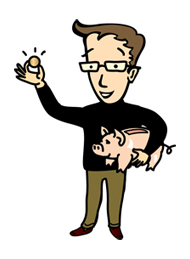 We have all heard stories about authors who receive million-dollar advances. Unfortunately, the author deals with huge advances are extremely rare. Around 300,000 books are published by the better-known publishers each year in America. Few become best sellers, some never get carried by bookstores.
We have all heard stories about authors who receive million-dollar advances. Unfortunately, the author deals with huge advances are extremely rare. Around 300,000 books are published by the better-known publishers each year in America. Few become best sellers, some never get carried by bookstores.
Typically, an author makes only 7–10% net from the sale of a book. Net sales are the actual profit from the book after wholesaler discounts, distributor fees, and retailer fees. Retailers typically take 40–50% of the cover price. So 7% net is not 7% of the cover price.
Your Royalty from a Publisher
Let’s say, for example, you spend a year writing a book and a publisher agrees to publish it for you. The cover price is $19.99. The publisher prints and sells 4,000 copies over a period of four years before no longer promoting the book. The publisher sells 1200 copies the first year, 2000 copies the second year, 600 copies the third year, and 200 copies the fourth year. Sales peak the 2nd year and then sharply decline the following two years. After the fourth year, the book is old news. The publisher is focused on selling new titles and, if your book is reprinted soon (unlikely), it is only selling a few copies per year—small pocket change with regard to royalties. Bear in mind that small publishers are more likely to print 2,000–4,000 books, rather than 10,000 or more.
When the books are sold the distributor/retailers will usually take 40–50% of the cover price. The publisher is then left with the remaining 50%. Of that 50%, the publisher pays out a royalty to the author of 7%. How does this add up?
4000 copies sold at $19.99 = $79,960 gross profit (profit before publisher expenses)
Distributors/retailers take 50%, leaving $39,980
Your royalty is 7% of $39,980 = $2798.60
The publisher has expenses, but likely netted around $30,000–35,000, while the author only got $2798.60. This is why publishers who publish many books with short print runs can still make a worthwhile profit, whereas most authors never make enough to cover their time.
A 7% return is on average, $699 per year over the course of the four years. This assumes the publisher didn’t offer any discounts on the cover price that reduce the profits and royalties further, as often happens. In total, the author makes $2798.60. With only 200 copies selling in the last year, the publishers doesn’t have enough demand to justify a new print run. The publisher controls the license agreement and will hold on to the book until there is an opportunity or enough demand to print more copies or the publisher may decide to sell the license agreement to another publisher.
In comparison, the total return on the same quantity independently published by the author and sold directly by the author at the full cover price ($19.99) is $54,576.40 (the profit after basic expenses). Which would you rather have: $2798.60 or publish it yourself and get $54,576.40?
Here’s another way to look at this: The publisher sells around 4,000 books and you get $2798.60 or on average $699 per year for four years. You personally sell only 35 books and you already get $699 minus your own publishing expenses.
Your Royalty if You’re the Publisher
Let’s take a closer look. Assume you have a simple book that is 6″x9″, 250 page, B&W interior, full-color cover.
You could do it yourself—the editing, cover design, and just flow the texts onto the pages with no regard for layout problems. Instead, you decide to follow publishing best practices. You hire a skilled editor for $1500. You hire a creative and skilled book designer for $2280 to do the cover and interior design, plus typesetting and professional press-ready files. You use print-on-demand (POD) to only print and ship 100 copies at a time, shipped directly to your home office. Just counting printing and shipping, the unit costs (cost per book) is $5.40. Let’s now scale this up to match the publisher who published 4000 copies.
The total unit costs for 4000 books is:
Editor $1,500
Pre-press $2,280 (Cover, interior design, page layout, and professional press-ready files)
Printing $21,600 (printing 100 at a time, including shipping and handling)
Total $25,380 (editing, design, pre-press production, press-ready files, and printing)
Remember, you don’t have to write a huge check for $21,600. You only print 100 books at a time, so the costs are more likely around $540 each time.
These are average prices that could vary depending on the book’s complexity and print method used. (In this scenario, I’m using print-on-demand. I will discuss the advantages and disadvantages, best uses, and when not to use POD in another blog post.)
Based on these estimated costs, the total investment is $25,380. The per book costs (unit costs) including editing, design, and printing is $6.34, and the cover price is $19.99, so the profit is $13.65 per book. This means the maximum possible net profit is $54,600 (meaning profit after editing, design and print costs are deducted).
Cost per unit book $25,380 /4000 = $6.34
Net profit per unit book $19.99 – 6.34 = $13.65
Therefore for a 4000 print run
Gross Income 4000 x $19.99 = $79,960
Total Cost 4000 x $6.34 = $25,360
Total Net Profit $79,960 – $25,360 = $54,600
A note on shipping costs: In this scenario, the assumption is that you, the publisher, are selling the books directly at workshops, seminars, and events and not through bookstores. If any copies are sold online, you are doing the order processing (known as “fulfillment”) and the buyer is paying for the shipping from your warehouse (which might be your home office). If, however, you were doing all the sales through your own website, you could eliminate all up-front printing cost and the costs of shipping books to your home office and just allow the POD provider to do the order fulfillment and print the book “on demand” as orders are made by buyers.
Be sure to read Part 2 of The Math Publishers Don’t Want Authors to Know! to find out how quickly independent publishing can become profitable.



